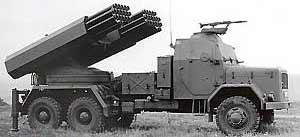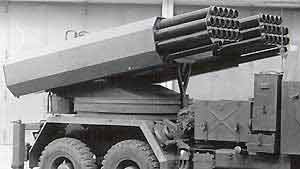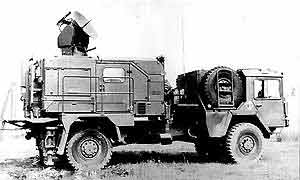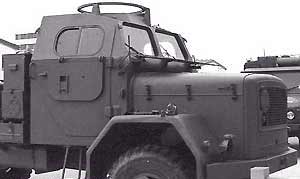| Designation: | LARS-1 |
 |
|---|---|---|
| Manufacturer: | Krauss-Maffei Wegmann GmbH & Co.KG - KMW | |
| Product type: | Weapons & Weapon Systems | |
| Name: | Multiple rocket launcher |
The 110 mm Light Artillery Rocket System (LARS) was developed in the 1960s and accepted for service with the Federal German Army in 1969, with first production systems being delivered the following year.
Prime contractor for the launcher was Wegmann and Company of Kassel (which merged with Krauss-Maffei in January 1999 with the new company being called Krauss-Maffei Wegmann GmbH & Co KG) and GUF was responsible for the rockets. The system was called the Artillerie Raketenwerfer 110 SF2 by the Federal German Army and was issued on the scale of one battery of eight launchers per division, with each battery having two (now Oerlikon Contraves) Fieldguard fire-control systems (on 4 × 4 truck chassis) and a resupply vehicle which carries 144 rockets.
The Federal German Army took delivery of 209 systems, but with the introduction of the longer-range 227 mm Lockheed Martin Missiles and Fire Control Multiple Launch Rocket System these 110 mm systems have now been phased out of service. It is possible that they may be passed onto another member of NATO.
The system underwent upgrading from LARS-1 to the LARS-2 in the mid-1970s. The programme has included a new fire-control system, more rocket types and mobility improvement by fitting the launcher to a new MAN (6 × 6) truck chassis. The MAN chassis is the standard 6 × 6 cross-country vehicle of the German Army and has improved mobility over the original chassis.
An air-transportable, towed, two-wheel, 15-round launcher was also developed by Dynamit Nobel but was not adopted by the Federal German Army. The same launcher was also tested on the rear of a Swedish Army Hägglunds Vehicle Bv 206 tracked vehicle, but by late 2001 this remained at the prototype stage.
The 110 mm Light Artillery Rocket System system consists of a MAN (6 × 6) truck chassis fitted with a cab and a multiple rocket launcher at the rear. Mounted on the roof of the cab is a 7.62 mm MG3 machine gun with an elevation of +9 to +50º, a depression of 0º and a traverse of 360º. The crew of three, consisting of the commander, aimer and driver, all sit in the unarmoured cab.
The launcher at the rear consists of two banks each with 18 barrels and is balanced by a sprung equilibrator and elevated by a mechanical drive system. A drive is also provided for azimuth changes. The panoramic sight Model 59 is mounted between and above the two banks of 18 barrels and the aimer is provided with a seat which folds forwards for travelling. Before the rockets are fired from inside the cab two mechanical stabilisers are lowered at the rear of the vehicle and the covers at the end of each bank of launchers are folded forwards through 270º so that they rest on top of the launcher.
The unguided fin-stabilised 110 mm rockets can be fired singly, part rippled or in a complete ripple. When ripple firing there is a half-second gap between each rocket being launched and the complete load of 36 rockets can be launched in 17.5 seconds. The standard rocket has a solid propellant motor which burns for 2.2 seconds. It has a minimum range of 6,000 m and a maximum range of 14,000 m.
More recently two higher-performance rockets have been built using the same rocket motor casing but with improved propellants. These have maximum ranges of 19,000 m and 25,000 m respectively. Total length for all three rockets with their warheads attached is 2.263 m and their total weight is 35 kg. The interchangeable warheads are all 0.95 m long, 0.109 m in diameter and 17.3 kg in weight. There is a wide variety available which includes the following LARS-1 types: the Diehl training warhead, the Diehl practice warhead, the Diehl DM-15 smoke warhead (containing 6 kg of a smoke-generating compound for a 15 minute duration smoke screen), the Dynamit Nobel DM-11 fragmentation warhead with an impact fuze, the Dynamit Nobel DM-21 fragmentation warhead with a 20 m, altitude-actuated, ground proximity fuze and the Diehl DM-701 dispensing warhead containing eight AT1 anti-tank mines. For the LARS-2, Dynamit Nobel has produced the DM-28 practice warhead (converted from the older DM-15 smoke warhead), the DM-39 radar target warhead (fitted with a radar reflector to act as the pilot shot for the Fieldguard radar system to measure actual trajectory paths for salvo firing), the DM-711 dispensing warhead containing five parachute-retarded 2.2 kg AT2 anti-tank mines and a new smoke warhead (containing 8.4 kg of a smoke-generating compound for a 15 minute duration smoke screen). The company has also developed for the German MoD a bomblet warhead (containing 65 M42 or M77 0.21 to 0.23 kg multipurpose shaped-charge fragmentation submunitions, containing 0.03 kg of explosive each with an effective fragmentation radius of 3 m and an armour penetration capability of 65 to 100 mm) that has yet to be ordered for the German Army. Once the 36 rockets have been launched the vehicle normally moves off to be reloaded to avoid retaliatory fire. The launcher takes 15 minutes to be reloaded.
The rocket is also used in a subcalibre training role with the German Army's MLRS. Details of this are given in the entry for the MLRS under the US.
|
||||||||||||||||||||
 |
 |
 |
 |
 |
 |